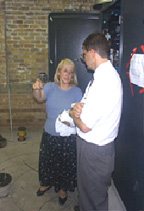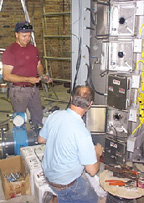|
Salt
Lake City Public Utilities treats 6200 South Well with UV/Oxidation System
to remove low levels of Tetrachloroethylene (PCE).
July 14, 1998
|
Electricians Steve Jacobs (left) and
Mike Bellah wiring the UV unit. |
The 6200 South well located at 2080 East and 6200 South is a critical water
supply for over 2000 connections in the Cottonwood area of Salt Lake County.
In 1993, a low level of the contaminant Tetrachloroethylene (PCE) was found
in this drinking water source. PCE is a suspected carcinogen regulated
under the 1986 Safe Drinking Water Act at a Maximum Contaminant Level (MCL)
of 5.0 parts per billion (ppb). The PCE measured at the well head
ranges from 0.5 to 4.5 ppb, below the MCL established by EPA. The public
was notified by a press release that the contaminant had been detected,
but was below the regulated MCL level. EPA and the State Department of Environmental
Quality were notified of the potentional problem. Subsequently, EPA conducted
an extensive study including boring test wells to locate the source of the
contaminant. The source was never clearly determined.
|
 Left: Florence Reynolds, Water Quality and Treatment Administrator
talks to John Meckler, Calgon Products Specialist.
Left: Florence Reynolds, Water Quality and Treatment Administrator
talks to John Meckler, Calgon Products Specialist.
|
The water meets drinking water standards, but the Department of Public Utilities
decided that it was obligated to its customers to provide drinking water
that was free of any detectable amount of a regulated contaminant. Again
after approaching local community leaders, councils and notifying all customers
by a message on their water bills, the department decided to treat the water
to remove any trace of the contaminant from the drinking water supply.
During the early part of 1998, the treatment process of UV/Oxidation
was selected and approved by the State Safe Drinking Water Board. The
Calgon Carbon Corporation's UV/H2O2 technology was chosen as the treatment
supplier. The equipment was manufactured at the Company's Toronto,
Canada plant during the spring and installed during late June and early
July 1998. Fine tuning the treatment process will conclude in mid-July
with the facility on-line for the heavy summer demand season.
According to Florence Reynolds, Water Quality and Treatment Administrator,
"The treatment process will provide drinking water free of PCE,"
adding, "…there are no secondary wastes or off-gases from the process."
She said, "By installing this equipment, it confirms our commitment
to provide the highest quality drinking water to our customers."
The treatment equipment can treat 3,000
gallons per minute at an O&M cost of $0.15 per 1,000 gallons. The
treatment costs will be spread across all of the Department of Public
Utilities cost of service budget, and the customers receiving the treated
water will not pay any additional amount on their water bills.
|

